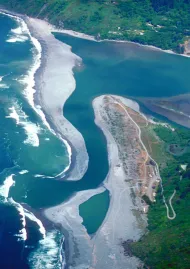Salmon, Dams, Farms: Contested Water in The Klamath River Basin

The Klamath River Basin is similar to many watersheds in the West. Historically, there was enough water for everyone living nearby, and farms and ranches and fisheries flourished. Drought and over-allocation of water rights exposed underlying tensions - there was not enough water to go around. Water scarcity created conflicts among neighbors, igniting tensions and tempers. A new era of water and resource management was needed. How can conflict be addressed?
This case study will look at the primary natural and social constraints and challenges facing the Klamath River Basin - including stressed tribal salmon fisheries, aging hydroelectric dams, and irrigation-reliant agriculture - and how communities have attempted to address them through the compelling, unconventional, and mainly unexpected collaborative approach of the Klamath Basin Restoration Agreement (KBRA) and the Klamath Hydroelectric Settlement Agreement (KHSA). An assessment of the potential impacts of the compromises made, and the limits of agreements that rely on federal approval and funding will also be included. Readers will be able to use this case to explore the academic and popular literature surrounding the Klamath basin, and apply lessons learned from the case to other resource management scenarios.